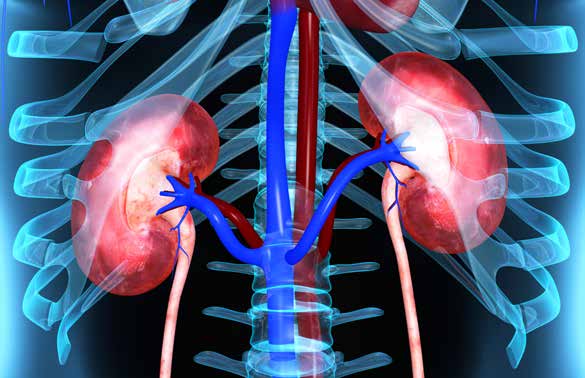Frontline Nivolumab Plus Ipilimumab Improves Efficacy in Metastatic RCC
Patients with more than 2 tertiary lymphoid structures, high Ki-67, and PD-1 positivity had high response rates to nivolumab plus ipilimumab.

Patients with metastatic renal cell carcinoma (RCC) who had more than 2 tertiary lymphoid structures (TLSs), an increased density of Ki-67 and PD-1 positivity elicited increased response rates and prolonged progression-free survival (PFS) with the combination of nivolumab (Opdivo) and ipilimumab (Yervoy) in the frontline, according to findings from the phase 2 BIONIKK trial (NCT02960906) that were presented at the 2022 ESMO Congress.
Several treatment cohorts were evaluated in the trial. Within 15 days of screening, patients were grouped into 1 of 4 molecular subsets. Patients in subsets 1 and 4 were randomly assigned to 3 mg/kg of intravenous (IV) nivolumab every 2 weeks or 3 mg/kg of IV nivolumab plus 1 mg/kg of IV ipilimumab every 3 weeks for 4 cycles followed by 240 mg of nivolumab every 2 weeks. Those in subsets 2 and 3 were randomly assigned to the combination or 50 of oral sunitinib for 4 weeks on, 2 weeks off, or 800 mg of oral pazopanib once daily.
With nivolumab alone (n = 38), patients with more than 2 TLSs achieved an objective response rate (ORR) of 73% (n = 8) vs 15% (n = 4) in those with fewer than 2 TLSs (chi-square P = .00195; HR for PFS, 0.31; 95% CI, 0.12-0.83; P = .015). With the combination (n = 76), 69% (n = 20) and 40% (n = 19) of patients experienced response with more than 2 and fewer than 2 TLSs, respectively (chi-square P = .0291; HR for PFS, 0.81; 95% CI, 0.44-1.46; P = .48).
“TLS >2 identify responders to nivolumab and nivolumab plus ipilimumab, and Ki-67- and PD-1–positive cell density identifies patients with longer PFS,” lead study author Maxime Meylan, PhD, research fellow at Dana-Farber Cancer Institute, said. “Patients with TLS >2 and high Ki-67 and PD-1 positivity have high response rates to nivolumab plus ipilimumab and longer PFS.”
BIONIKK is a hypothesis-generating, noncomparative, per-molecular group randomized phase 2 trial.
The trial enrolled patients at least 18 years of age with treatment-naïve, metastatic clear cell RCC with an ECOG performance status between 0 and 2 and frozen tumor tissue. Patients with active brain metastases were excluded from enrollment.
Treatment was continued until disease progression, death, or end of study.
A total of 160 samples underwent immunohistochemical and immunofluorescence staining to assess TLS, PD-1, and Ki-67 level.
The primary end point was investigator-assessed objective response per RECIST v1.1 criteria. Key secondary end points were PFS, overall survival, time to subsequent therapy, time to objective response, and duration of response.
Additional results showed that higher density of PD-L1– and Ki-67–positive cells was associated with improved ORR and PFS with nivolumab. The ORR was 40% (n = 6) with nivolumab in patients with high expression vs 26% (n = 5) in those with low expression (chi-square P = .633); with the combination, these rates were 56% (n = 25) and 45% (n = 14), respectively (chi-square P = .511).
However, the median PFS was not different between cohorts of high or low expression with nivolumab alone (HR, 0.73; 95% CI, 0.32-1.65; P = .44). Only with the combination, did patients with high expression level outperform those with low expression (HR, 0.49; 95% CI, 0.28-0.88; P = .014).
Finally, the investigators showed that the presence of both high TLS and PD-1/Ki-67 positivity enhanced response rates and PFS for the combination. In this population, the ORR was 81% (n = 17) vs 40% (n = 21) in those without both markers (chi-square test P = .00319). Moreover, the PFS was favorable in the population with more than 2 TLSs and Ki-67 positivity vs those without (HR, 0.53; 95% CI, 0.26-1.07; P = .074).
Notably, 95% of patients enriched with both markers (n = 20) who received treatment with the combination did not experience early progression within the first 6 months of therapy vs only 64% (n = 34) of those without both markers.
Meylan added that preliminary peripheral blood mononuclear cell analysis indicated that select circulating CD4 T-cell populations were also associated with response.
“Validation of these markers on immunotherapy and TKI/immunotherapy [combinations] is ongoing,” the study authors concluded.
Reference
Meylan M, Sun CM, Elaidi RT, et al. In-situ and circulating immune markers predict nivolumab +/- ipilimumab efficacy in frontline metastatic clear cell renal cell carcinoma: key ancillary analyses from the BIONIKK randomized trial. Ann Oncol. 2022;33(suppl 7):S660-S680. doi:10.1016/annonc/annonc1072
Enhancing Precision in Immunotherapy: CD8 PET-Avidity in RCC
March 1st 2024In this episode of Emerging Experts, Peter Zang, MD, highlights research on baseline CD8 lymph node avidity with 89-Zr-crefmirlimab for the treatment of patients with metastatic renal cell carcinoma and response to immunotherapy.
Listen
Beyond the First-Line: Economides on Advancing Therapies in RCC
February 1st 2024In our 4th episode of Emerging Experts, Minas P. Economides, MD, unveils the challenges and opportunities for renal cell carcinoma treatment, focusing on the lack of therapies available in the second-line setting.
Listen
Peers Discuss Management of IO/TKI Toxicities and Dosing Strategies in Frontline RCC
March 11th 2025During a Case-Based Roundtable® event, Elizabeth M. Wulff-Burchfield, MD, and other participants discussed their experiences with the frontline combination regimens for advanced renal cell carcinoma.
Read More